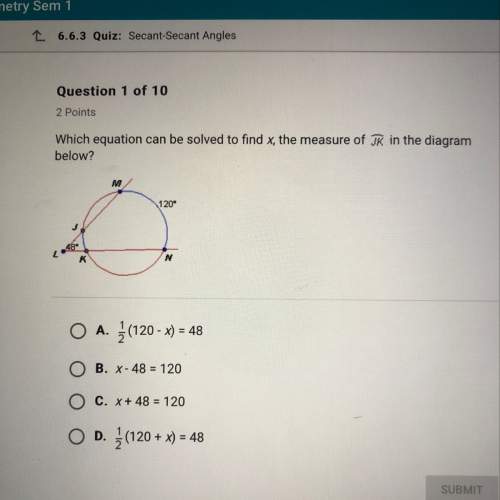Please help. This is my last question and all I need is an answer
...

Mathematics, 10.10.2020 15:01 hajanaetowens
Please help. This is my last question and all I need is an answer


Answers: 3


Another question on Mathematics

Mathematics, 21.06.2019 22:00
Asystem of linear equations with more equations than unknowns is sometimes called an overdetermined system. can such a system be consistent? illustrate your answer with a specific system of three equations in two unknowns. choose the correct answer below. a. yes, overdetermined systems can be consistent. for example, the system of equations below is consistent because it has the solution nothing. (type an ordered pair.) x 1 equals 2 comma x 2 equals 4 comma x 1 plus x 2 equals 6 b. no, overdetermined systems cannot be consistent because there are fewer free variables than equations. for example, the system of equations below has no solution. x 1 equals 2 comma x 2 equals 4 comma x 1 plus x 2 equals 12 c. yes, overdetermined systems can be consistent. for example, the system of equations below is consistent because it has the solution nothing. (type an ordered pair.) x 1 equals 2 comma x 2 equals 4 comma x 1 plus x 2 equals 8 d. no, overdetermined systems cannot be consistent because there are no free variables. for example, the system of equations below has no solution. x 1 equals 2 comma x 2 equals 4 comma x 1 plus x 2 equals 24
Answers: 3

Mathematics, 22.06.2019 02:40
Given a = {(1, , 5)(6,4)}, b = {(2,0)(4, ,5)(0, 0)) and c = {(1, 1)(0, 2)(0, 3)(0, ,5)}, answer the following multiple choice question: from the list of sets a, b, and c, state the domain of set b. domain of set b: {0, 6,5} domain of set b: {2, 4,-4, 0} set b does not have a domain
Answers: 3

Mathematics, 22.06.2019 03:30
One angle of a linear pair is 10 more than two-thirds the other angle. find the measure of both angles.
Answers: 1

Mathematics, 22.06.2019 06:00
1. which answer is the solution set to the given inequality? 2x+6< 8 a. x e (-∞,1) b. x e [1,∞) c. x e (1,∞) d. x e (-∞,1] 2. which answer represents the given compound inequality in interval notation? x≥12 or x< -4 a. x e [-4, 12) b. x e (-∞, -4) u [12,∞) c. x e (-∞, -4] u (12,∞) d. x e (-4,12] 3. which answer is the solution set of the given compound inequality? 7> x+6 or x-2≥3 a. x e (-∞, 1) u [5,∞) b. x e (1, 5] c. x e (-∞, 1) ∩ [5,∞) d. x e [1,5) 4. which conjunction or disconjunction is equivalent to the given absolute value inequality? |x+3|> 12 a. x+3> 12 and x+3< -12 b. x+3< 12 and x+3> -12 c. x+3< 12 or x+3> -12 d. x+3> 12 or x+3< -12
Answers: 1
You know the right answer?
Questions





Mathematics, 28.09.2020 14:01


Geography, 28.09.2020 14:01



Biology, 28.09.2020 14:01



History, 28.09.2020 14:01


Spanish, 28.09.2020 14:01

Mathematics, 28.09.2020 14:01







